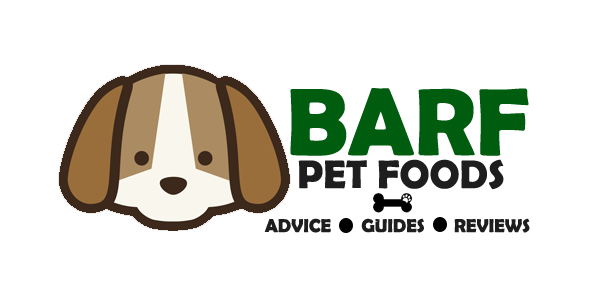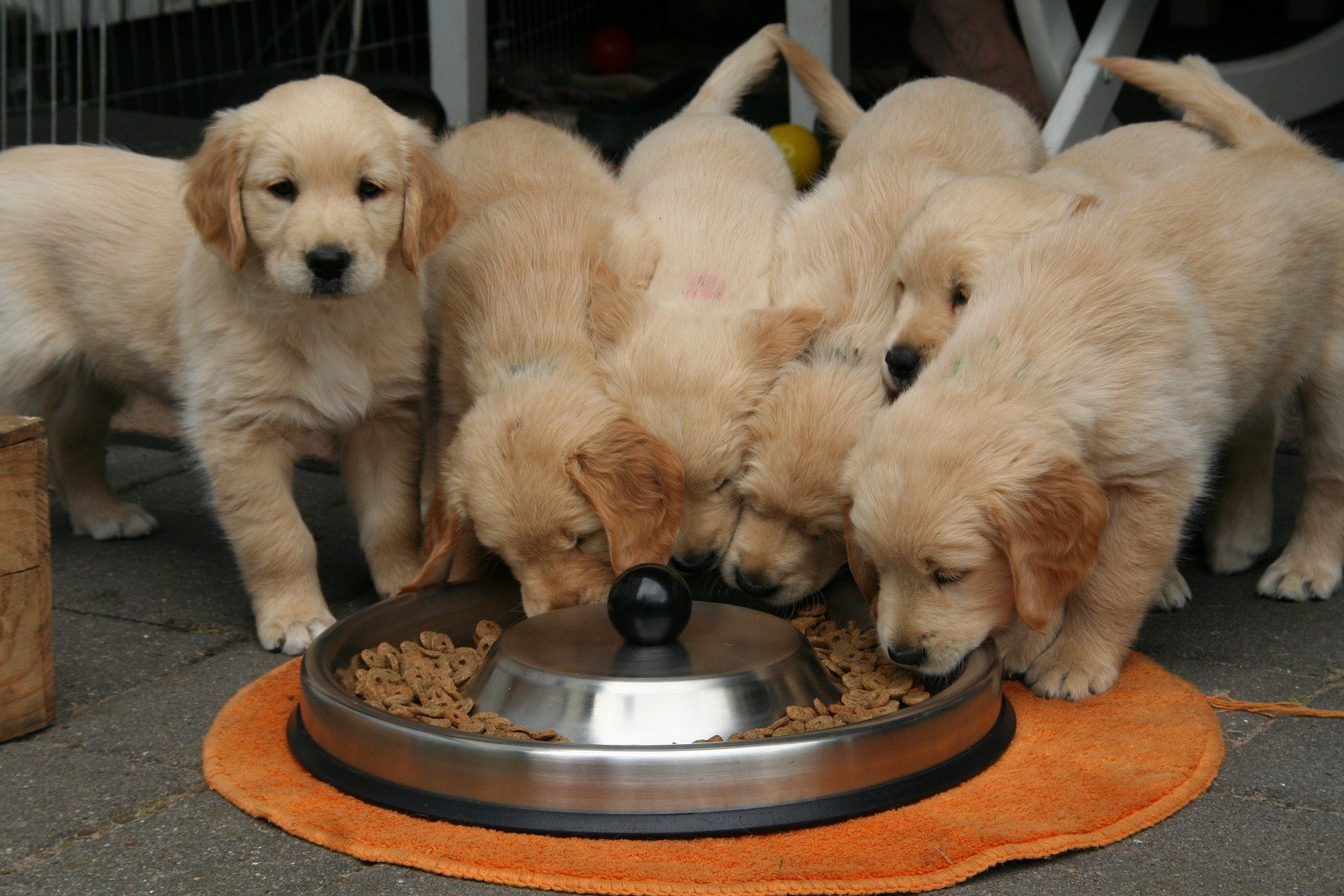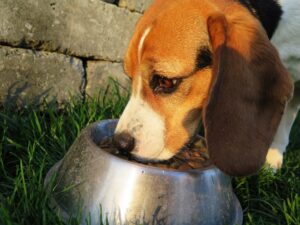In today’s post, Skinner’s ‘Field & Trial’ puppy food will put under the microscope. We’ll be looking at both their dry and wet food offerings and using our expert knowledge of puppy food (and the pet food industry in general) to give you an unbiased review of Skinner’s wet and dry foods for puppies.
Our approach to reviewing pet foods is simple: see what the marketing blurb on the company’s website says; analyse the ingredient profile and analytical constituents of the food(s) in question, then see if the latter backs up the former.
Given that some companies wax lyrical about products that don’t meet up the lofty expectations set out by their (typically over-the-top) advertising patter, it’s essential to dig down and critically analyse exactly what’s in the food, what it does, whether it’s healthy, and whether it’s worth your hard-earned cash. After all, your puppy’s health is paramount, and not too far behind that is your wallet – two things we here at BarfPetFoods care about – hence why we write these 100% honest, impartial reviews.
So, if you’re considering Skinner’s dry and/or wet puppy food(s), you’ve certainly made the right choice by visiting us today. We’ll not be leaving any stone unturned, that’s for sure!
Skinner’s Field & Trial Dry Puppy Food
We’ll begin proceedings by looking at Skinner’s best-selling dry puppy food ‘Field & Trial’, which comes in three different flavours: Chicken, Lamb & Rice, and Duck & Rice.
As we always do when we review animal foods, we’ll start by casting our eye over the marketing blurb of the products before analysing the ingredient profile and analytical constituents to see if they do indeed ‘walk the walk’ after ‘talking the talk’ in the aforementioned advertising spiel.
According to Skinner’s website, their Field & Trial Puppy food has been formulated to be not only a complete puppy food but also one that supports the early growth and development of puppies from the age of three weeks to six months. It goes on to state that Field & Trial Puppy food has been carefully developed to ensure the appropriate levels of essential nutrients are provided in an easily-digestible form, with the kibble pieces designed to suit all puppies regardless of breed, age, or size.
Some of the benefits listed include:
- Maintenance of healthy bones and teeth.
- Immune system support.
- Helps to improve stamina.
- Aids joint and provide joint protection.
- Maintenance of a healthy coat.
- Build strong, healthy muscles.
- Wheat gluten-free.
- Contains the prebiotic mannan oligosaccharide (MOS) to support gut health and development.
Sounds impressive, huh?
The question is, do the ingredient profile and analytical constituents back up all of the above marketing patter, or does Skinner’s Field & Trial Puppy food miss the mark?
Let’s find out.
We’ll begin by examining the ingredient profiles of each flavour.
Chicken: Chicken meat meal (min 30%), maise, chicken fat, brown rice, oats, maise gluten meal, sunflower meal, whole linseed, beet pulp, whole dried egg, vitamins, minerals, yeast, MOS.
Lamb & Rice: Whole rice (38%), lamb meat meal, naked oats, sunflower oil, pea protein, linseed, whole peas, brewer’s yeast, beet pulp, sunflower expellers, whole dried egg, vitamins, minerals and trace elements.
Duck & Rice: Duck meat meal (28%), brown rice, peas, oats, sunflower oil, whole linseed, beet pulp, yeast, marine algae, vitamins, minerals and trace elements, MOS.
Next, we’ll take a look at the analytical constituents, namely protein and fat content.
Chicken: 27% protein; 18% fat.
Lamb & Rice: 24% protein; 12% fat.
Duck & Rice: 27% protein; 18% fat.
So what does this tell us?
Well, when trying to decipher whether or not a puppy food is going to be a healthy choice for your little four-legged friend, the main factor that needs to be considered is protein and fat levels – in addition to where the protein(s) and fat(s) come from, i.e. how much protein and fat is there and do they come from high-quality sources?
Puppy food should contain at least 24% protein, and, in an ideal world, the protein:fat ratio should be somewhere around 1:.75. Plus, the protein should largely come from high-quality sources, i.e. meat, eggs, etc.
So what does the above tell us about Skinner’s Field & Trial Puppy food?
Well, it tells us that two flavours – Chicken and Duck & Rice – are a better option than the Lamb & rice flavour. Why? Because a) they contain more protein and fats, and b) the first ingredient on the list is meat/protein-based rather than carbohydrate. That’s not to say the Lamb & rice flavour isn’t a good puppy food; it’s just not as good a choice as the other two. Therefore, if I were buying Skinner’s puppy food, I’d certainly opt for the Chicken flavour first, Duck & Rice second, and Lamb & Rice last.
‘Why Chicken over Duck & Rice?’, you’re no doubt wondering.
There’s not too much difference between the two, but the primary fat source of Chicken flavour is chicken fat as opposed to sunflower oil; the former contains higher levels of EFAs (Essential Fatty Acids) compared to the latter. However, both have added linseed, which is also a healthy source of fats, so it could be argued that Chicken is only fractionally ‘healthier’ than Duck & Rice. Either way, they’re both packed full of protein and good fats.
The only downside to Skinner’s puppy food is the amount of (what are commonly referred to as ) ‘fillers’, i.e. inexpensive carbohydrates to bulk out the food and make it cheaper to produce. While there’s nothing inherently wrong with maise, rice, oats, beet pulp and the like, it’s always nice to see a little less carbohydrate – both in terms of overall amounts and number of sources – and a little more protein and healthy fats. That being said, Skinner’s puppy food isn’t meant to be a premium option; therefore, moderate levels of ‘filler’ carbohydrates are to be expected.
Where Skinner’s puppy food shines most, however, is its price. A 15kg sack, i.e. a volume of food that would last for many months, costs a mere £30 – just £2 per kilo. Given that we here at BarfPetFoods know everything there is to know about dog food and the dog food industry, we can safely say that Skinner’s puppy food is exceptional value for money. Period. In fact, we can’t think of any other puppy food of a similar quality that is as inexpensive.
Our verdict: While Skinner’s ‘Field & Trial’ dry puppy food can’t be described as premium quality or as a food that will turn heads or set the world of puppy alight, it can be described as middle-of-the-road puppy food that is very inexpensive. Those on a strict budget would be foolish to look elsewhere if seeking a puppy food that contains high levels of ‘good protein and fats that is affordable month-in month-out.
Skinner’s Field & Trial Wet Puppy Food
Like the vast majority of puppy food manufacturers, Skinner’s also offers wet food for puppies – so let’s see how this performs.
According to the marketing blurb, Skinner’s wet puppy food is made from 100% natural ingredients, contains a full range of vitamins and minerals, contains moderate amounts of protein and fat, is easy to digest, is highly palatable, is grain-free, and is perfect for puppies who are fussy eaters.
Sounds good, right? But what doe the ingredient profile and analytical constituents tell us?
Chicken & Garden Veg: Chicken (60%), carrot (2%), potato (2%), parsnip (1.5%), dried egg, natural ground bone, dried seaweed, vitamins and minerals.
Next, we’ll take a look at the analytical constituents, namely protein and fat content.
Chicken & Garden Veg: 12% protein; 10% fat.
At first glance, the protein and fat content appears to be far too low; however, wet foods are always lower in protein and fat (and carbohydrates) per 100g simply because they’re natural, rather than being highly concentrated and processed like dry dog foods. For example, a puppy consuming 100g of dried food per day would typically consume at least double this amount in wet food; the total amount of protein and fats consumed per daily serving will be similar.
What’s great about wet puppy food is the fact that it’s far more natural and less processed than dry food. While dogs are more than capable of digesting (and being completely healthy on) dry food, the more natural a puppy food is, the better.
The only downside of wet puppy food, in general, is that it is more expensive than dry food (for obvious reasons) – typically around three to four times more expensive. However, if you want to provide your puppy with a completely natural and less processed food, Skinner’s Field & Trial Puppy food is a fantastic choice.
Note: Unlike their dry puppy food, Skinner’s wet puppy food can be fed to puppies up to 18 months of age.






